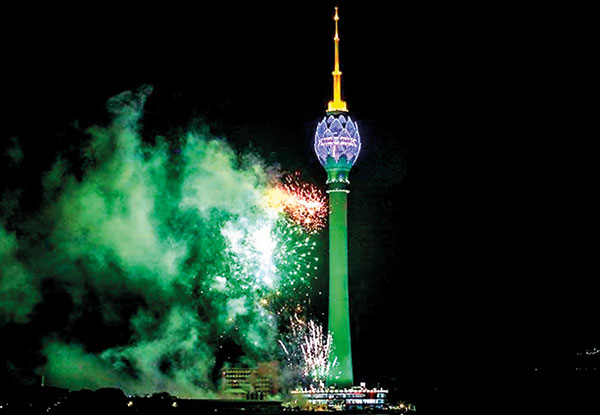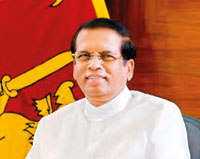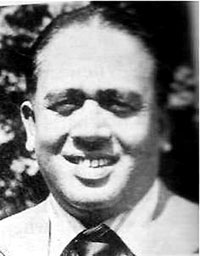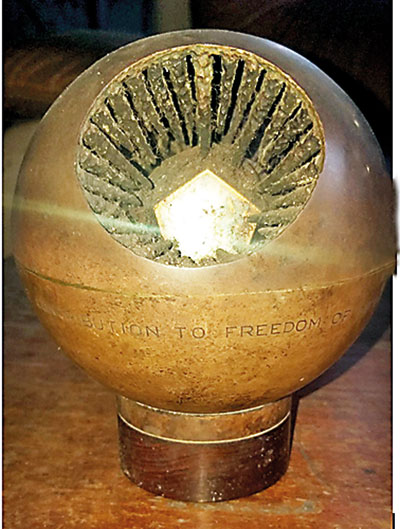Columns
Mystery of the missing 2 billion buck stigma of the Lotus Tower

THE LOTUS TOWER: The tallest tower in South Asia built at a cost of US$ 104 million or Rs 18 billion
Perhaps, it was not the best of all possible auspicious times for President Sirisena to reveal at the grand ceremonial opening of the Lotus Tower this Monday that a massive two billion bucks paid as an advance to a Chinese company had gone missing along with the Chinese company even before the first foundation stone had been laid for the tower project in 2012 under the Rajapaksa regime.

President: Serious allegation
It was as if the stigma at the centre of the lotus had been stolen even before the bud had bloomed.
Even though the night time sky was awash with sweeping lights and an impressive fireworks display as the Lotus Tower blossomed into operations, the most incredible and resounding firecracker was ignited by President Sirisena and the fallout the most damaging.
In the dazzling flare lit to expose the alleged two billion buck scam, Sirisena claimed that Rs. 2 billion that was paid by the Sri Lankan government in 2012 as an advance to a Chinese owned company called ALIT for the construction of the Lotus Tower had disappeared from the books. He said: “The estimated cost of the tower was Rs. 19 billion. EXIM bank, China was to provide Rs. 16 billion. On 3rd January 2012 the Telecommunications Regulatory Commission (TRC) signed a tripartite agreement with CEIEC and ALIT to construct the Tower. We paid Rs. 2 billion to ALIT but this sum is missing from records. In fact, ALIT is a fake company.”
In the presence of Chinese envoy in Sri Lanka, Cheng Xueyuan, the President stated: “In 2012, an advance payment of Rs. 2,000 million was made to ALIT company in China. In 2016 ALIT disappeared. I then personally and then officially instructed our Chinese ambassador Mr. Karunasena Kodituwakku to conduct an inquiry to ascertain what happened to the company called ALIT.”
“We informed the then Chinese Ambassador to Sri Lanka about this matter,” the President said. “I told our envoy in China Mr. Kodituwakku to personally check on ALIT company who had also been a signatory of the Tripartite agreement. The address given by the company was an address in Beijing. Therefore, I told him to inform the Chinese foreign ministry and also go to this Beijing address personally and check on the matter. He personally went to the given address. The address was correct but there was no company by that name there or anywhere else in China. Thus the advance of two billion was not there. Neither was the company. It was as a result this that Sri Lanka was given only Rs. 12 billion by EXIM, the Chinese bank.”
 However, former TRC Director General Anusha Palpita refuted President Maithripala Sirisena’s allegation. Palpita said the money had been transferred to an account maintained by CEIEC at the EXIM bank.
However, former TRC Director General Anusha Palpita refuted President Maithripala Sirisena’s allegation. Palpita said the money had been transferred to an account maintained by CEIEC at the EXIM bank.
Not even the prevailing rains could douse the ire of former President Mahinda Rajapaksa when informed of Sirisena’s allegation and the insinuation it contained. In fact, he was absolutely livid.
The day after the Colombo wedding reception of his son Namal held at Mount Lavinia Hotel where the President was an honoured guest, Mahinda Rajapaksa hit back describing the Sirisena allegation as a ‘complete falsehood’ designed to ‘throw stones at the opposition on the eve of a presidential election. Furthermore, he said, to cast such an allegation was an insult to China, a major world power that has always been friendly and helpful to Sri Lanka, is unconscionable. And, by uttering it in the presence of the Chinese Ambassador, only made it worse.
The former President stated this Wednesday: “At the time that this payment was made in 2012, the TRC which was in charge of this project was directly under me as the President. The Exim Bank of China agreed to provide a loan facility of 88.6 million USD or up to 85% of the total project cost. The remaining 15% of the cost had to be borne by the TRC.
Rajapaksa stated. “Documents confirm that on 9 October 2012, the TRC had credited 15 million USD (Rs. two billion) to the account of the main contractor China National Electronics Corporation. The latter company is still the main contractor of the project. The advance payment of Rs. two billion was never paid to the other contractor ALIT.
On Thursday, Sri Lankan Ambassador to China Dr. Karunasena Kodituwakku issued a clarification regarding the Lotus Tower Project allegations. In it he said: “In mid 2018, His Excellency President Sirisena telephoned me in Beijing and requested that I look into the whereabouts of ALIT, as letters posted to it by the Telecommunications Regulatory Commission of Sri Lanka had been returned to Colombo informing that no such company was at the given address.
Kodithuwakku went onto say: “I then entrusted the task of tracing the current location of ALIT to the Head of the Commercial Section of the Embassy of Sri Lanka in Beijing. After much effort, the Embassy found that the company had moved to a different location, as well as withdrawn from the Lotus Tower project without informing the TRC. Once the company’s new premises were located, we visited it and met the officials who were present there at the time. They then informed us that their company ALIT was no longer involved in the Lotus Tower project.”
COPE chairman JVP MP Sunil Handunnetti on Tuesday moved into action and declared that an exhaustive inquiry would be commenced to every aspect of the Lotus Tower Project. He said that officials of institutions including TRC would be asked to be present before the committee to give evidence in the probe of allegations pertaining to the Lotus Tower. “Since we already have the Auditor General’s report, we can pursue the matter in a speedy manner and swiftly arrive at its conclusions.”
But even if Mahinda’s explanation, Koddithuwakku’s clarification and the COPE findings show that the president had embarrassed himself by making such a damaging allegation without paying due diligence as to its veracity, not to worry. A flock of lambs have already been earmarked for slaughter at the altar of presidential credibility. On Wednesday, the UPFA General Secretary had an escape route lined up in case the worst should transpire.
Addressing a media conference, Mr. Amaraweera said, “If President Maithripala Sirisena’s claim that Rs. 2 billion was missing from the investment of Lotus Tower Project turns out to be incorrect, it is obvious that officials who gave him the figures are to be blamed for such misinformation.” In other words, the sins of their political masters will visit the public officials. They will have to take the rap.
When and if the COPE should get down to the business of probing the Lotus Tower affair, it should not fail to inquire and give answer to two important questions: Two questions that baffle the public mind.
The first billion buck question is why the President, in 2018, chose to turn his ambassador to China into a Sherlock Holmes and task him to do some amateurish investigative work when he could easily have entrusted it to trained investigators from the FCID or CID?
The second billion buck question is why the President, having harboured such suspicion for so long, chose the ceremonial opening of the Lotus Tower this Monday to allege in public the great Chinese two billion buck vanishing trick?
| Knight defender of Lanka’s press freedom Sepala Gunasena was a man with two sides to his character. On the one hand he was blessed with a kind heart and a humorous spirit. On the other, he was embedded with a tough and unbending stance and willing to sacrifice all to uphold his principles. He was a gentleman with gentlemen but, if the need arose, could be a thug with thugs.  SEPALA GUNASENA: 96th Birth Anniversary Malagalage Don Sepala Gunasena was born on 22nd September 1923, the eldest son of Lanka’s Sinhala pioneer book publisher M. D. Gunasena. He had his early education at St. Sebastian College, Moratuwa when at the age of 9 he was packed off to study at Trinity College, Kandy. After his father passed away in 1959, he succeeded him as the Chairman of M. D. Gunasena and Company. But though he was in the book publishing and the printing business, a passion that had possessed him since his college days, still burnt within him: To start a newspaper that reflected public opinion, that gave voice to the voiceless millions in the villages, that was non partisan, that was truly independent whose motto would be ‘publish and be damned’. In 1960, Sepala Gunasena began turning his dream into reality. He founded Independent Newspapers Ltd and was fortunate to attract the doyen of Lanka’s journalism D.B. Dhanapala who became the founding editor of the company’s flagship the DAVASA. The company went on to publish three national dailies, namely, the Sinhalese daily the DAVASA, the English daily the SUN and the Tamil daily the THINAPATHI. It also published the Sunday newspapers, the Sinhalese RIVIRASA, the English WEEKEND and the Tamil CHINTHAMANI. At one point till 1974 when the company was sealed, it even published three evening newspapers, the Sinhala SAVASA, the English STAR and the Tamil THANTHI. It also published a host of weeklies. Though a Buddhist himself, and though his Sinhala newspapers mainly catered to a Sinhala Buddhist grassroot readership, he himself was one who embraced all religions and was liberal in his thinking. In 2016, the Catholic newspaper the Gnanartha Preedeepaya celebrated its 160th year. As the Catholic Messenger published on 12 June 2013 as its lead story, with the headline ‘His Grace explains magnanimous gesture of Buddhist publisher during crisis time at CCP’, the former Archbishop His Grace Oswald Gomes in his speech as chief guest, said: “It was the time when the catholic schools were being taken over. It was crisis time for us at the Catholic press. The then government controlled newsprint and had severely restricted our quota. It was at this time Sepala Gunasena came forward to give a helping hand at a time of crisis. From the stocks he had to publish his own newspapers, he released 25 percent of it to us. Mr. Gunasena’s gesture at great personal risk was indeed magnanimous and a great blessing for us.”  COMMONWEALTH PRESS UNION ASTOR AWARD: Presented in 1974 for his ‘notable contribution to freedom of information’ Sepala Gunasena was very much a hands-on publisher. In 1970 after bringing the SLFP-leftist coalition to power with a massive majority in the House, Gunasena’s newspapers gave voice to the people’s hardships caused by the economic policies of the leftist influenced Sirimavo Government. Sepala Gunasena’s newspapers strongly campaigned against the takeover of the Lake House group of newspapers. But it was to no avail. And soon the bells would toll for his newspapers, too. On 17th April 1974, the presses of Independent Newspapers were sealed under emergency law. In that same year the Commonwealth Press Union presented Sepala Gunasena the prestigious Astor Award ‘for his notable contribution to the freedom of information’. Since the Sri Lanka Editors Guild was launched in 1999, it annually presents an award titled ‘Sepala Gunasena Award for the defence of press freedom in Sri Lanka’ but only if there is a recipient who merits it that respective year. After the Davasa Group was sealed, entreaties were made by the SLFP leadership that the presses would be unsealed and free to publish again if an undertaking was given to be pro government. Sepala Gunasena’s reply was tacit. He said; “If I am not free to publish my newspapers on my own terms, I do not wish to publish them at all. In early 1977 the government dissolved Parliament and announced the holding of elections. With the need to ratify the emergency laws — under which the newspapers were sealed — every month, the emergency laws lapsed automatically for want of ratification and, as a result, the newspapers, too, were automatically unsealed. The company started publishing again on 31st March 1977 and, of course, backed the UNP which won with a record five sixth majority. But the bonhomie was not to last for long. In 1977 the newly elected Prime Minister J.R. Jayewardene presented a bill in Parliament to abolish the existing one and to replace it with a new constitution that would create an Executive Presidential form of Government. Queen’s Counsel S. Nadesan, known as the Fox of Hulftsdorp, submitted to the Sun a series of articles critical of the proposed constitutional bill, highlighting the dangers inherent in it — of vesting in one man so much power. After the Sun had published the first installment, Sepala Gunasena was summoned to meet Prime Minister JR who asked him to stop the publication of the articles forthwith. This was the Prime Minister who had just won power with over a five sixth majority and was now in the process of introducing a new constitution that would make him executive president of the country with almost absolute power except the power, as JR once boasted, ‘to make a man a woman and a woman a man.’ Sepala Gunasena’s reply to JR’s demand was to simply say: “Sir, if I have trespassed upon the laws of my country, take me to court, but I cannot stop the articles from being published.” The Government did not take the company to court. However it charged Mr. Nadesan for breach of parliamentary privilege. Mr. Nadesan appeared for himself in court and won his case even as Sepala Gunasena won the lasting displeasure of President Jayewardene. In the late 1980s, threatening clouds were hovering over Independent Newspapers. In 1990 the Government institutions began withdrawing their advertising, the state banks suddenly recalled the loans that had been given to the company. And on August 14 the banks published an ex parate notice in the government newspapers to sell the properties mortgaged as collateral for the loans immediately by public auction. The hour had come to pay the supreme price for his determination to maintain an independent free press in the country, unbeholden to any politician. And on December 26th 1990, the presses that printed the DAVASA, SUN and a whole host of others finally ceased to roll. Sepala Gunasena passed away at the age of 69 on Thursday June 10th 1993. On June 13, the day after his funeral, the Sunday Times editorial stated: “As twilight fell over Kanatte yesterday, the mastheads of all newspapers were dipped in tribute as thousands ranging from proof boys to editors and publishers gathered to take Sepala Gunasena through his last sunset. The spirit of Sepala Gunasena, the spirit that on many occasions inspired him to speak out at heavy personal cost, will form a glorious page in the history of journalism in Sri Lanka.” | |
| Who’s the ghost? It wasn’t the eleventh hours but rather well past it when a tawdry attempt was made to abolish the executive presidency at an emergency cabinet session held this Thursday. The extraordinary cabinet session was summoned by the president who said it was done so at the request of ‘someone’ but did not divulge who the ghost was. True, Mahinda Rajapaksa was known to be for abolishing the executive presidency – it had been his election promise in 2005 and in 2010 – true the JVP was for it, true the UNP and the SLFP and even some of the minority parties were all for it. But the nagging question was whether it was the time to even consider the idea and hoist upon the nation a new constitution that had not received sufficient public discussion and debate, especially at a time when the country had entered the twilight zone with the election commission having declared on Wednesday October 7 as nomination day and November 16 as presidential polls day, at a time when applications for postal votes were being issued and deposits of candidates were already being accepted? Abolishing the executive presidency at such a time would have been akin to staging Hamlet without the Prince. Plus the constitutional procedure would have to be followed and a two thirds majority in Parliament plus a national referendum would have to be held. It was not a simple affair like amending some minor traffic law. So who mooted this foolish motion that served only to bring the present Government into further contempt? And why did the government, having had four and a half years to keep its solemn election promise, suddenly decide to raise the old ghost from its sepulchre at the very last moment when the time was well past to do so? Luckily the move was thwarted. As the Good Book says: There’s a time for everything. And this was certainly not a time for constitutional abolishment but a time for the constitutional duty to hold presidential election. Unfortunately some in the cabinet failed to grasp this biblical wisdom. Or, for that matter, lacked simple common sense.
To Father SUNDAY PUNCH ODE By Don Manu Thou will not return or pass this way again; Thy breath shall no more softly blow against us, Nor thy presence uplift the brooding pall Or serve to banish the surrounding gloom That shrouds our hopes yet exposes our fears. Thy voiceless lips shall no more blaze life’s truths Or give full flow to thy wisdom’s noble fount; Nor thy eyes mirror the anguish of our souls Or bear witness to our relentless strife; Nor thy ears echo our pathetic wail Or hear the plaintive cry of wretched woe. Yet, though thou art gone, thy beacon still shines, Thy sacred flame, thy primordial fire still burns, And will guide us through this tempestuous night, Through the swell and surge of the deepest roar, To reach the nearest port, the safest shore. In the flesh of your flesh, blood of your blood Moves thy spirit ever omnipresent; And, till inexorable fate snuffs out my flame, Will reside within, sacred and immortal.
|


Leave a Reply
Post Comment